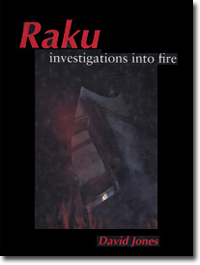Rick Foris
Contemporary Raku Ceramics
 "The
American potter Rick Foris makes dramatic work. His formative influence
was potter John Natale, “Whose work always knocked me out.
Every time I’d see his work, at art fairs or galleries, it
would evoke a “God, why didn’t I think of that!”
response. He generally made simple vessel shapes adorned with the
most outrageous doodads – the pieces always looked so ceremonial.
That did, and still does, interest and excite me’. Like many
artists, Foris covers the traces of the sources for his influences,
very carefully kicking dust in the face of anyone who enquires too
closely into his motivation: "The
American potter Rick Foris makes dramatic work. His formative influence
was potter John Natale, “Whose work always knocked me out.
Every time I’d see his work, at art fairs or galleries, it
would evoke a “God, why didn’t I think of that!”
response. He generally made simple vessel shapes adorned with the
most outrageous doodads – the pieces always looked so ceremonial.
That did, and still does, interest and excite me’. Like many
artists, Foris covers the traces of the sources for his influences,
very carefully kicking dust in the face of anyone who enquires too
closely into his motivation: I’ve always liked throwing, and my shapes tend to be pretty classical in nature. People are always asking me what my influences are – they think the pieces look Chinese, Egyptian, Mayan, and I think they’re disappointed when I tell them ‘none of the above’. I generally go into the studio with only my past pots as an influence and extrapolate from there. In fact, I try not to look at too much pottery for guidance as regards shape and style – I probably look at more architectural or natural shapes (seed pods, fruits and the like) for inspiration than anything else. There is a powerful sense in his work of an artist creating his own ancient civilization, destroying what is there and presenting us with the artifacts that he has retrieved. There are no documents, and so an aura of mystery pervades the pieces. This absence of information extends even to those vessels that have an allusive hieroglyph pattern as a decoration in relief. Foris was one of the potters whose work defined the nature of the fumed copper glaze; however, he grew increasingly frustrated by what he perceived were its limitations, and the straitjacket that seemed to be placed around him through his association with a technique. This was an interesting dilemma, because it actually provided much of what he wanted aesthetically. It wasn’t, though, a fundamental and integral artistic and philosophical necessity like Rick Hirsch’s relationship to the surface ; rather it was a technique that, increasingly, failed to deliver the goods: After working with the copper matt glaze for ten years of so, my surfaces shifted more and more to the use of acrylics for their colour … copper matt had turned into a monster. By the mid-80s, the copper matt surfaces were becoming a cliché. Many potters have been seduced by the superficial
‘flashiness’ of Raku, only to reject this surface value
as their vision of the work that they wish to make becomes clearer
in their mind. Rick has taken elements of this rich vocabulary,
both crackles and luster, and supplemented it with post-firing painting
with non-fired acrylics." |
189 County Road ZZ North - Amherst Junction, Wisconsin 54407 - 715.824.2809